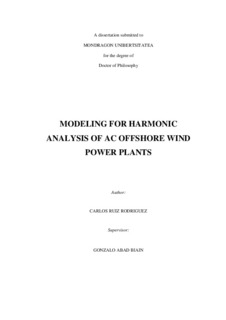
Ikusi/
Izenburua
Modeling for harmonic analysis of ac offshore wind power plantsEgilea
Zuzendaria(k)
Irakurtze Data
2020-03-17Argitalpen data
2019Beste erakundeak
Universitat Politècnica de Catalunya (UPC)Universitat Politècnica de València (UPV)
Universidad Carlos III de Madrid
Ingeteam (Spain)
Dokumentu-mota
Doktore tesiaDoktore tesiaHizkuntza
engEskubideak
© Carlos Eduardo Ruiz RodriguezSarbidea
Sarbide irekiaArgitaratzailearen bertsioa
https://doi.org/10.48764/42h8-r896Argitaratzailea
Mondragon Unibertsitatea. Goi Eskola PoliteknikoaGako-hitzak
ODS 7 Energía asequible y no contaminanteLaburpena
This Ph.D. dissertation presents the work carried out on the modeling, for harmonic analysis, of AC offshore wind power plants (OWPP). The studies presented in this Ph.D. thesis are oriented to two ma ... [+]
This Ph.D. dissertation presents the work carried out on the modeling, for harmonic analysis, of AC offshore wind power plants (OWPP). The studies presented in this Ph.D. thesis are oriented to two main aspects regarding the harmonic analysis of this type of power system.
The first aspect is the modeling and validation of the main power components of an AC offshore wind power plant. Special emphasis is focused on the modeling of wind turbines, power transformers, submarine cables, and the interaction between them.
A proposal of a wind turbine harmonic model is presented in this dissertation to represent the behavior of a wind turbine and its harmonics, up to 5 kHz. The distinctive structure of this model consists of implementing a voltage source containing both the fundamental component and the harmonics emitted by the converter. For the case of transformer and submarine cables, the frequency-dependent behavior of certain parameters is modeled for frequencies up to 5 kHz as well. The modeling of the frequency-dependent characteristics, due to skin and proximity effect, is achieved by means of Foster equivalent networks for time-domain simulations.
Regarding the interaction between these power components, two complementary modeling approaches are presented. These are the Simulink®-based model and an analytical sequence network model of the passive components of the OWPP. A description of model development and parameterization is carried out for both modeling approaches considering a scenario that is defined according to a real offshore wind power plant.
On the other hand, the second aspect of this Ph.D. thesis is oriented to the analysis of the issues that appear in offshore wind power plants in relation to harmonic amplification risk, compliance of grid codes in terms of harmonics and power factor, and the design of effective solutions to improve the harmonic emission of the facility. The technical solutions presented in this Ph.D. thesis cover aspects regarding modulation strategies, design of the connection filter of the grid side converter and management of the operation point of the grid side converter of wind turbines. This last by means of changing the setpoint of certain variables. As inferred, these are solutions from the perspective of the wind turbine manufacturer. [-]
Bildumak
- Tesiak - Ingeniaritza [243]




















